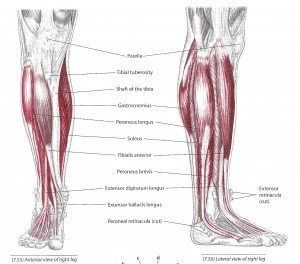 Among the many fascinatingly weird things going on in the human body (symmetries and asymmetries, anatomical anomalies), we have the lower leg or shin. Imagine the upper leg where we have the massive quadriceps at the front of the thigh with the three hamstrings working in opposition at the back.
Among the many fascinatingly weird things going on in the human body (symmetries and asymmetries, anatomical anomalies), we have the lower leg or shin. Imagine the upper leg where we have the massive quadriceps at the front of the thigh with the three hamstrings working in opposition at the back.
The lower leg has the calf muscles that I have been writing about, at the back, while the front of the shin has but one lonely muscle, the tibialis anterior.
The tibialis anterior muscle originates on the upper third and towards the outside of the tibia and inserts into the side and underneath the first, or innermost, cuneiform bone and at the base of the first metatarsal bone of the foot.
It acts to dorsiflex (bring the toes closer to the shin) and invert (turn in) the foot. The tibialis anterior muscle is involved in all walking and running activities and very often the pain referred to or diagnosed as shin splints is an injury to the tibialis anterior muscle.
It accomplishes different actions and interacts with several muscles depending on the action at hand.
It works with and against the tibialis posterior to support the inner arch of the foot. It both stabilizes the foot on contact and enables the lifting of the foot to continue whether walking or running.
It can also solidify the foot and ankle complex when kicking a ball. In these actions, the tibialis anterior muscle interacts with the soleus, plantaris, gastrocnemius, and the peroneus longus.
This is a lot of work for one little muscle on its own at the front of the shin.
There seems to me to be some David and Goliath thing going on in the image to the right.
One muscle against an army of muscles with only a tibia and fibula between them…
The foot, ankle, and shin are designed to create a right angle when standing and even walking.
Runners who develop shin splints invariably hit the ground with the shin at an obtuse angle to the foot which creates a strain on the tibialis anterior that leads to pain.
Proper walking patterns and good posture both align the tibialis anterior muscle correctly and employ it successfully which keeps it toned and supple.
If you are one of the many people that hyperextend your knees when walking and standing, your tibialis anterior muscle is not getting used the way it should if it is being used at all.
